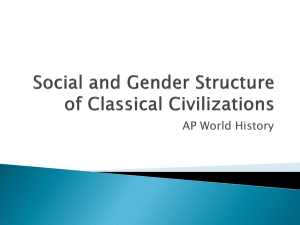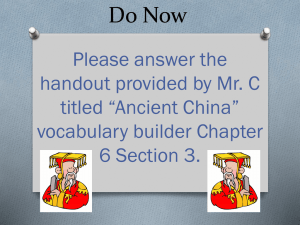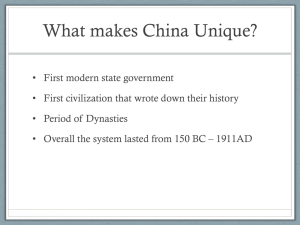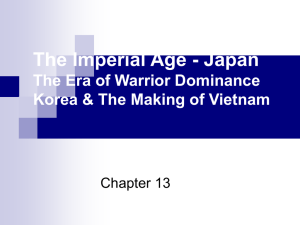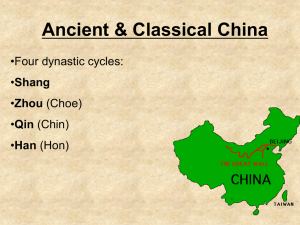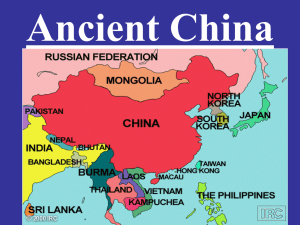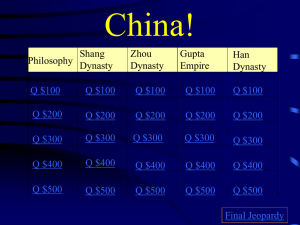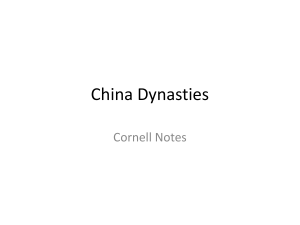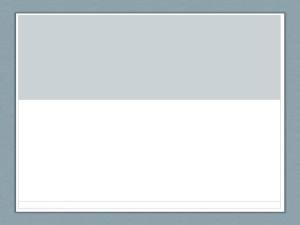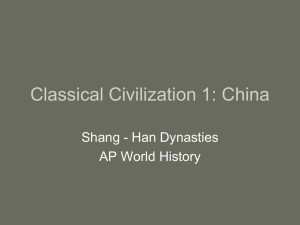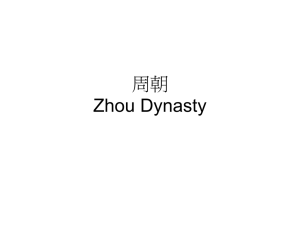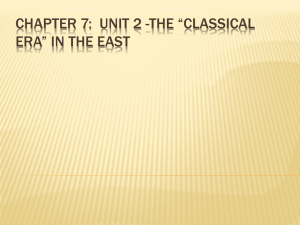India and China - Tarleton State University
advertisement
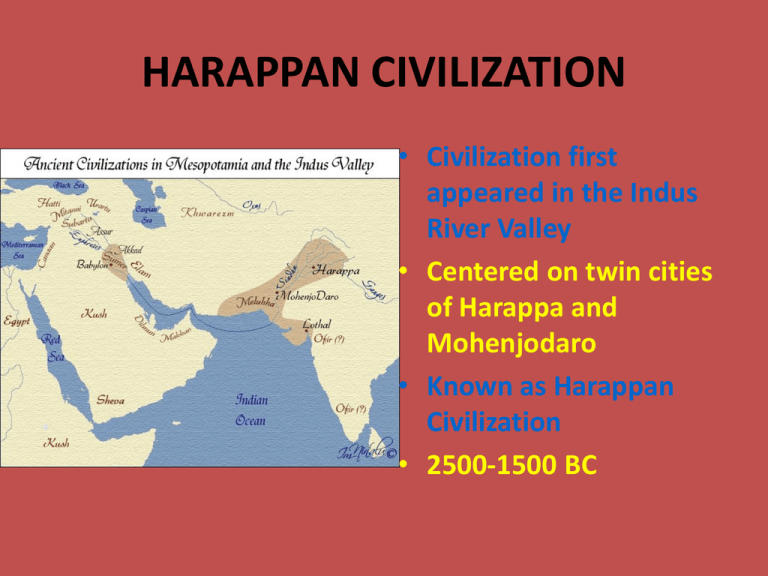
HARAPPAN CIVILIZATION • Civilization first appeared in the Indus River Valley • Centered on twin cities of Harappa and Mohenjodaro • Known as Harappan Civilization • 2500-1500 BC CHARACTERISTICS • Encompassed most of modern-day Pakistan • Produced barley and wheat • Used copper, and then bronze, tools • Traded with places as far away as Egypt • Developed a writing system MOHENJODARO • Streets laid out on grid pattern – Indicated planning • Elaborate underground sewer system – Used both for carrying off storm water and waste • Clay brick architecture – Some buildings four stories tall ARYANS • Invaders from southern Russia • Entered region around 1500 BC • Destroyed Harappa and Mohenjodaro and massacred their inhabitants • Plunged region into “Dark Age” – Cities abandoned, writing forgotten, and people reverted to Neolithic lifestyle – Lasted 500 years (15001000 BC) REVIVAL OF CIVILIZATION • Urban life revived in villages in the Ganges River Valley around 1000 BC – Inhabited by hybrid people (part Harappan/part Aryan) – Evolved into city-states – Caste system also evolved at the same time • Became unique Indian social phenomenon CASTE SYSTEM I • Society was at first divided into four castes – Warriors – Priests – Merchants/landowners – Small farmers/laborers – System was not especially rigid and there was a great deal of mobility in both directions CASTE SYSTEM II • System grew more complicated and rigid with time – Ultimately there would be hundreds of castes • Each was forbidden from having any social contact with the others – At the very bottom were the “untouchables” • The mere accidental touch of one was considered to be polluting MAURYAN EMPIRE • 16 small city-states existed in the Ganges River Valley by 600 BC – Each ruled by an individual with the title of raja • One city-state grew in power at the expense of the others – Magada • Conquered entire Ganges Valley and beyond • Created Mauryan Empire ASHOKA Chandragupta Maurya Ashoka Mauryan Empire founded by Chandragupta Maurya Most famous ruler was his grandson, Ashoka Began reign as a military conqueror but, following a battle in southern India, he decided to rule in a different, more gentle, way MORE ASHOKA • Promised to be mild with his subjects, always place their welfare before his own ambitions, and to refrain from offensive military operations • Kept his word – Engaged in numerous public works construction projects – Dug thousands of wells – Constructed thousands of hospitals – Built rest areas along roads – Encouraged economic activity • Reign was a true “golden age” for India END OF THE MAURYAN EMPIRE • Within 50 years of Ashoka’s death, the Mauryan Empire collapsed – Due to a series of invasions from barbarians to the north – Shattered unity and plunged region into anarchy • Characterized by a constantly-shifting mosaiac of warring citystates – Lasted 500 years THE GUPTA EMPIRE • Around 300 BC, the ruler of Magada (again) gradually conquered the entire Ganges River Valley – Chandra Gupta I • Process would be continued by his son and grandson – Result in the creation of the Gupta Empire END OF THE GUPTA EMPIRE • First century of Gupta Empire was a time of expanding power, growing prosperity, and cultural achievement • But after the death of Chandra Gupta III, the empire was invaded by the White Huns – From Central Asia – India disintegrated into numerous petty kingdoms again INDIAN ACHIEVEMENTS • Invented several writing systems • Developed an elaborate literature – Mostly religious in content • Developed our modern number system – Called “Arabic numerals” • Invented the decimal system • Created the foundation for algebra • Discovered that the earth was a rotating sphere HINDUISM • In Aryan times, Indians were polytheistic – But, over time, three of their more important gods merged together into a three-part monotheistic deity called Brahman • Brahma (creator) • Vishnu (preserver) • Shiva (destroyer) • Brahman permeated everything in the universe REINCARNATION • Doctrine of reincarnation came from belief that all living things were related and had souls – Belief that each soul is reborn in the body of another creature over and over again • The form that one is reborn into is determined by one’s actions during their lifetime – Known as karma – Good Karma=reborn into higher caste – Bad Karma=reborn into lower caste or even lower life form WHEEL OF SUFFERING • Also believed that human existence was basically an endless round of suffering – We are all trapped on the “Wheel of Suffering” with no permanent way off – The only escape is through meditation • Merging oneself with Braham • But this was only a temporary escape GAUTAMA THE BUDDHA • As Hinduism became the dominant religion in India, it also became more worldly and materialistic – Prompted appearance of “gurus” around 600 BC • Wanted to put Hinduism back on track by making it more spiritual • Most notable guru was Gautama the Buddha (Enlightened One) – Would create a new religion in his quest for a more spiritual life BUDDHA AND THE WHEEL OF SUFFERING • Buddha was especially concerned to find permanent escape from the Wheel of Suffering • Taught that the basic cause of human suffering was desire – The fruitless quest to acquire more and more material things • Argued that this never made a person happy because they always wanted more • Did think meditation was the complete answer either – Since it only provided temporary escape NIRVANA • Only way off the Wheel of Suffering was to go through an eight-step process that involved changing your entire life – Included rejection of selfish worldly desires. the cultivation of honesty and compassion, rejection of violence, and cleansing your mind of all evil thoughts – Successful result was the attainment of “nirvana” • Permanent escape from the Wheel of Suffering and the attainment of permanent peace and tranquility BUDDHA IN ACTION • Buddha practiced what he preached – Only possession were the robe on his back, a walking stick, and wooden bowl – Always travelled on foot and slept outdoors – Presented his creed in simple language – Accepted persons from all castes and treated them equally • Attracted millions of converts across Asia DIVISION • Hinayana Tradition (“Little Vehicle”) – Buddha was just a man • Mahayana Tradition (“Big Vehicle”) – Buddha was a god, the human incarnation of Brahman – Led to construction of temples and creation of statues devoted to his worship – By far the most popular of the two traditions today SHANG DYNASTY • Civilization emerged from Neolithic settlements along the Huang-ho River around 1500 BC • Shang rulers were primarily military leaders – Also acted as chief priests in times of peace ANCESTOR WORSHIP • Shang Chinese were polytheistic – Chief god was Shang-ti • Chinese believed that Shang-ti was too powerful to be approached directly by human beings through prayer – Began praying instead to dead relatives who had entered the spirit world where Shang-ti lived to intercede with the god • This practice of praying to dead relatives for aid and support continued even after belief in Shang-ti had faded away ZHOU DYNASTY • According to legend, the last king of the Shang Dynasty committed unspeakable crimes against the gods and his people – Prompted two aristocrats from the region of Zhou to lead a rebellion against him – Replaced his dynasty with one of their own • Zhou Dynasty • 1000-221 BC MANDATE OF HEAVEN • Chinese believed that Shang rulers had been picked by the gods to rule – Therefore it might look as though the Zhous had defied the wishes of the gods by overthrowing the Shangs • Zhous therefore developed concept of the Mandate of Heaven – Dynasties had the right to rule because they had special permission from the gods – But this permission could be revoked if they abused their power and given to another dynasty Shang-ti QIN DYNASTY • By the last 200 years of the Zhou Dynasty, the kingdom had disintegrated into a collection of small, independent states, continually at war with each other – A new power emerged out of this mess around 300BC • The state of Qin began conquering its neighbors and, by 221 BC, it had taken over all of northern China • Ruler of Qin, Shihuangdi, takes title of “First Emperor” and founds Qin Dynasty QIN ACHIEVEMENTS • Shihuangdi’s armies then conquered most of the rest of China – Set up centralized administrative system • Divided realm in 36 districts, each administered by an appointed governor – Established a standard system of weights and measures, uniform coinage system, and a standard alphabet – Built numerous roads and canals – Began work on the “Great Wall” BIG DOWNSIDE • Shihuangdi drove his people mercilessly – Imposed heavy taxes – Imposed forced labor – Brutally crushed all dissent • Even burnt books • Became obsessed with finding magic potion that would give him immortality – Died in 210 BC while searching for potion HAN DYNASTY • Death of Shihuangdi was followed by civil war – All Qin family members were killed – Ultimate victor was Lui Bang • Former bandit leader • Founded the Han Dynasty – 202 BC-220 AD – So beloved by Chinese that they call themselves the “People of Han” today HAN HISTORY • Lui Bang continued centralizing policies of Shihuangdi – But had the common sense to go easier on his people • Greatest Han ruler was Han Wudi – Extended Han power into Tibet, Korea, and Mongolia – Established relations with Japan – Created the “Silk Road” • Trade route that stretched from China, through India, and into Europe • Han Dynasty collapsed in 250 AD due to civil war, rebellions, and invasions SILK ROAD WRITING • Writing first appeared during Shang Dynasty – Oracle Bones • First books appeared during Zhou Dynasty – Made from sheets of bamboo • Alphabet was standardized under Shihuangdi – Has changed little since • Paper invented during Han dynasty – Used to produce a rich and varied literature CONFUCIUS • Best known Chinese “sage” was Confucius – Lived during anarchy of the late Zhou Dynasty – Teachings were written down after his death by his students in a book called the Analects – Primarily concerned with the issue of how human beings could live together harmoniously in society HIERARCHY • Advocated a society where everyone had a specific place and performed all the obligations associated with that place – Called this “Hierarchy” – A rigid system but it did help to preserve harmony and order in an increasingly overcrowded country for a long time GENTLEMAN • Originally, the term “gentleman” meant a person of high status by virtue of their birth • Confucius gave the term a moral meaning – Gentleman was a person who behaved in a virtuous manner • Since anyone could do this, anyone (regardless of their social status) could be considered a gentleman • Confucius argued that one’s place in society should be determined by their behavior and personal qualities, not by their wealth or birth DAOISM • Allegedly founded by Laozi – Author of Daodejing (“The Way”) – May or may not have been a real person – Allegedly lived during the last years of the Zhou Dynasty DAOIST THEOLOGY I • The Dao is the unseen root of all things – It provides balance and harmony to the universe – Everything, including human beings, is a part of it • Because human beings have free will and desires, they are capable of acting “unnaturally” and thereby upsetting the natural balance within the Dao – Purpose of Daoism is to teach people to return to their natural state of behavior, to behave in such a way as to restore the balance of the Dao DAOIST THEOLOGY II • Human beings should engage in wu wei – Means “acting spontaneously” and “flowing with the moment” • If human beings want to be in harmony with the universe, with the Dao, they should simply do what feels good and right to them at the moment – Should act in a simple, unselfish, and humble manner • Without artifice • No role-playing, game-playing, or dishonesty – Just be yourself
